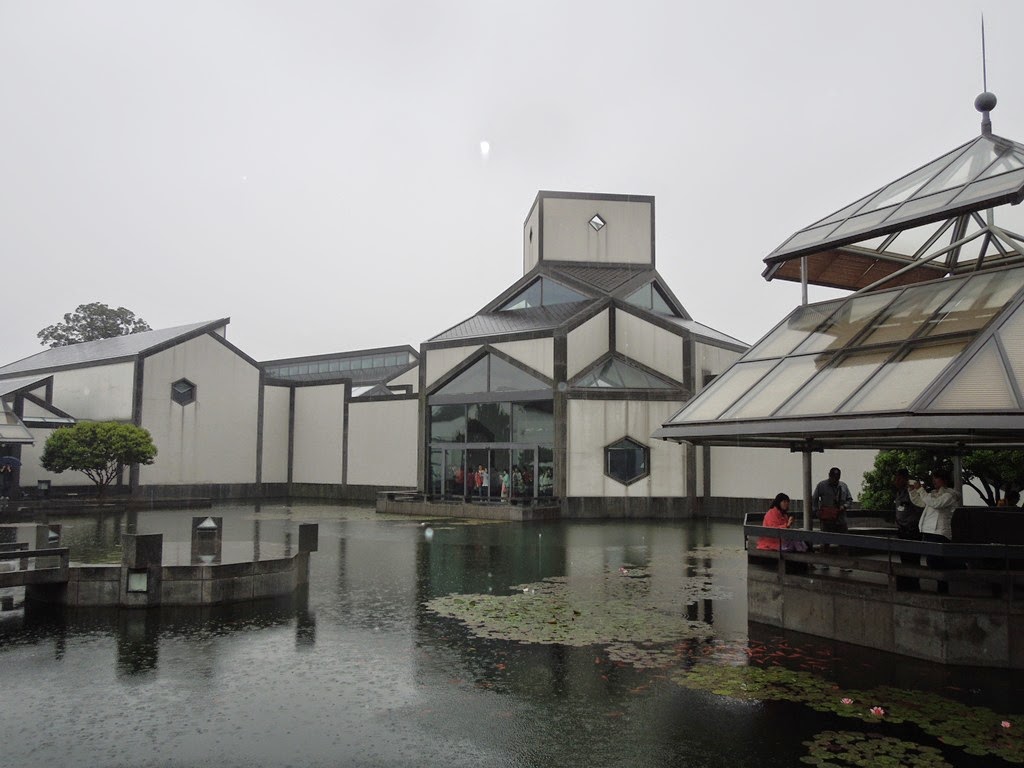Sunday in Sūzhōu 苏州 - still threatening to rain as we purchased breakfast from a stand across the road from the Píngjiāng Lodge 平江客栈:
Killing time after breakfast before heading out. My daughter trounces her mother at Go 围棋. Inspired by the Japanese anime アニメ Hikaru no Go ヒカルの碁, Amber has been playing the game for a couple of years now and is taking classes on it a couple of times a week here in Shànghăi 上海:
Mom and daughter pose outside of a teahouse on Pingjiang Lù 平江路. This particular establishment hosts performances of Chinese opera, though high table fees would later dissuade us from going inside to watch:
Early morning canal scenes:
Our first sightseeing stop of the morning was the Suzhou Museum 苏州博物馆, designed by rock-star architect I.M. Pei (who was apparently inspired in his youth by the city's gardens). Amazingly, admission is free of charge - visitors are allowed entry in small groups, leading to long lines out front to get in (fortunately for us, we arrived early enough so that the wait was short). The collection is as varied as the building design (both interior and exterior) is inspired:
Adjacent to the museum and part of the same complex is the former home of one Lĭ Xiùchéng 李秀成, a general during China's unbelievably bloody and destructive Taiping Rebellion:
The one sight Pamela really wanted to see in Suzhou was Tiger Hill 虎丘, so we flagged down a taxi and headed off in that direction. It seemed a lot of other people had the same idea, for we soon found ourselves in a traffic jam. The cab driver eventually suggested it would be quicker if we got out and walked the final two kilometers to Tiger Hill's entrance gate. He was right:
The main drawing card of Tiger Hill is the Yúnyán Pagoda 云岩寺塔, completed in the year 959 and standing 47 meters (154 feet) high:
It wasn't until I walked over to the northeast side of the pagoda and had a closer look that I realized it had a noticeable tilt, ala the Leaning Tower of Pisa:
The leaning of the pagoda was more obvious the further back I stood:
The steps leading away from the pagoda took us to a Buddhist temple:
In Northeast Asia, it's perfectly normal to see young women doing a fan dance in front of a giant teacup:
As we made our descent, the tour groups were ascending - a non-stop sight in Suzhou. Amidst the din, a lone gŭzhēng 古筝 player gave a short recital. My wife recently started taking lessons in how to play this traditional instrument:
Returning to Pingxiang Lu from Tiger Hill proved to be the kind of adventure one doesn't want to experience. Figuring a taxi would be too slow-going in the traffic, we got on a public bus and managed to find seats, a good sign (or so it seemed). The bus then took a different route away from the congested main road, and it appeared we would have an easy ride back into the center of town. Fat chance - with each stop, more and more people boarded while few got off, to the point where it felt like the bus would burst open. The worst part came when it was our turn to disembark - those staying on the bus wouldn't budge, especially those standing closest to the exit doors, while one grandfather was yelling that his grandson was about to vomit. I had no choice but to elbow and shove as hard as I could, both to get off the bus and to ensure Amber didn't get crushed to death. Needless to say, it was a great relief to set foot on the pavement, and wave a not-so-fond farewell to one of uglier aspects of living in China - the daily battle to get what you need in a society where there are still too many people going after too few opportunities. Like getting on and off a public bus, for example.
After the bus ride from hell, the wide-open spaces and vast elbow room of Pingjiang Lu came as a great relief (as did the fried squid):
As the afternoon began to wane, we had time to visit one more sightseeing spot - the Kūnqŭ Opera Museum 戏曲博物馆, dedicated to one form of Chinese opera and housed in a beautiful Ming dynasty-era building. We were lucky enough to catch a class of teenage girls rehearsing in front of their mothers and teacher:
The rain eased up long enough for us to enjoy dinner outdoors by the canal. My wife was still hungry afterward, however, so she bought some stinky tofu 臭豆腐 from an inconveniently located convenient food stand:
Back to the Pingjiang Lodge to pick up our bags, and time for one last look at a couple of courtyards there:
It turned out that Suzhou had a subway system which, while there are only two lines running at present, turned out to be a lot more convenient for getting to the train station than the taxi we had been told by the hotel staff we should take when we had arrived on Friday evening (cheaper, too). For the short high-speed train ride back to Shanghai, we were given tickets for a soft sleeper cabin. My daughter, naturally, wanted the top bunk:
The weather was lousy and the crowds (as well as bus rides) exhausting, but overall Suzhou lived up to its hype as a local tourist attraction. It's worth a visit, but do yourself a favor and go on a weekday - your blood pressure will thank you for it.














































































